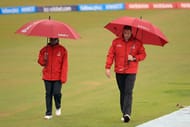Rain-affected matches

Before the World Cup 1992, the rule in case of rain interruptions was to deduct runs-per-over of the first innings for each over lost in the second innings. The new rule for the World Cup 1992 was if rain interrupted play in the second innings, the reduction in the target was to be proportionate to the lowest scoring overs of the side batting first.
That panned out disastrously when South Africa were chasing against England in the semi-final, needing 22 runs off 13 balls for victory. Rain interrupted play then and after that, the total was first revised to 22 off 7 balls and then 22 off just 1 ball, robbing South Africa of a likely chance of victory.
By 1999, the Duckworth-Lewis method was introduced which in case of a rain interruption, sets a revised target for the chasing team based on statistical calculations. The method not only takes into account the run-rate and overs bowled but also the wickets lost based on which it makes its calculation.
After the retirements of Frank Duckworth and Tony Lewis, Professor Steven Stern became the custodian of the method which was renamed in 2014 as the DLS method.
Looking for fast live cricket scores? Download CricRocket and get fast score updates, top-notch commentary in-depth match stats & much more! 🚀☄️
